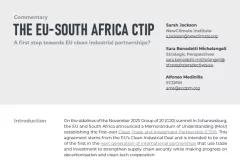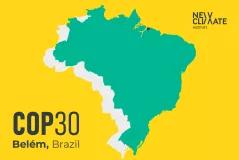A new tool to evaluate integrated climate action of non-state and subnational actors
The world now faces a critical juncture as countries are updating their next wave of NDC climate targets. To ensure ambitious and inclusive target setting and implementation, governments must build on existing efforts to recognize and integrate the full range of non-state and subnational actions into national goals. The ICAT Climate Action Aggregation Tool (CAAT) has been developed to support government experts, analysts and policymakers to analyze potential emission reductions of non-state and subnational actions (NSAs) and increase ambition beyond existing climate targets. The CAAT is a collaborative effort between NewClimate Institute, World Resources Institute, and the Initiative for Climate Action Transparency (ICAT) and is the latest addition to the ICAT Assessment Guides, implementing the methodology described in the Non-state and Subnational Action Guide.
The value of a whole-of-society approach
Efforts by national governments to reduce emissions are currently insufficient to avoid what the science tells us is necessary to avoid catastrophic levels of warming. As of now, only 50 countries and the EU-27 bloc, representing 31.6% of global emissions and 25.2% of global population, have officially submitted or proposed new NDC updates (Climate Action Tracker). Just how ambitious these new commitments are—and how quickly and effectively national governments move to make good on them—will determine whether the coming years mark a true turning point in efforts to lower emissions, or whether we fall short.
To ensure the next wave of climate commitments rises to the moment, a ‘whole-of-society’ approach facilitates the assessment of how action at smaller scales of governance contributes to and enhances national goals. Non-state (e.g. businesses) and subnational (e.g. regions, states, and cities) actors can play a pivotal role in the implementation of NDCs. A growing body of research—including global studies and country-specific analysis for the U.S.—shows that their integration into national-level goals can increase ambition well beyond existing targets.
While the potential is there, the majority of NDCs still do not integrate the mitigation efforts of non-state and subnational action (NSAs). Novel analytical approaches and tools are required to (1) better quantify the impact of region, city, and business emissions reduction efforts, (2) evaluate how they overlap with or complement national policies, and (3) determine the impact of combined national and subnational efforts for integration into more holistic target-setting These approaches are exemplified in the studies cited above. Building on emerging research and methods in this area, NewClimate Institute, in partnership with World Resources Institute, has developed a tool to do just that.
CAAT: an integrated, user-friendly NSA-analysis tool
The ICAT Climate Action Aggregation Tool (CAAT) guides users in a step-by-step process to define a research scope, compile NSA data for bookkeeping, and perform analyses at various levels of complexity in a user-friendly, macro-enabled Excel file.
All calculations, analytical components, and peer-reviewed methodologies are fully integrated to produce actionable results in an array of summary statistics, tables and graphs tailored to users’ selected assessment objectives and defined scope. This allows users of various technical and non-technical backgrounds to conduct the assessment without extensive experience in the topic and present the findings in clear, understandable formats.
The CAAT was developed with the user at the center, with functions such as data validation checks, buttons, and info boxes embedded throughout the tool to guide users in their assessments. The tool is further supplemented with a user introduction presentation, methodology note, data collection template, and video training. The CAAT can deliver results for the following primary use cases:
- Landscape analysis describing the number of actions, action and actor types, temporal ranges, and emissions covered by NSAs. Users can use this information to get an overarching perspective on the breadth of actors pursuing climate action, assess the nature and ambition levels of sectors and actor groups, and identify frontrunners and laggards in climate action.
- Impact and overlap analysis aggregating annual potential emission reduction impacts from NSAs for any year between 2015 and 2050. The CAAT helps users determine a reference GHG emissions scenario and a scenario under target realization for each action, and to calculate potential impact in terms of GHG emission reductions. Further, it includes built-in functions and methodologies for the analysis of overlaps between NSAs from different actor groups to depict potential emission reduction impact more accurately. Users can use this information to assess the magnitude and significance of NSAs and their possible impact on carbon budgets.
- Comparison of NDC or other policy scenarios with integrated projected emission reductions from NSAs. Users can input up to five defined national emission pathways from various policy scenarios (e.g. business-as-usual, current policies, or NDC) in the tool to further assess the extent to which NSAs can contribute to achieving—or exceeding—regional and national climate targets. The results can be used to determine the need for additional climate action or the ratcheting up of targets.
Results section of the CAAT tool.
Enabling integrated climate action analysis and planning at scale
Already, the ICAT NSA Guide and this CAAT tool are being put into practice to evaluate regional and local climate actions and integrate them into top-down climate goals. For example, working directly with government stakeholders in Colombia, a team of independent analysts leveraged both resources to evaluate municipal and private sector contributions to emissions reductions and their potential contribution to the country’s revised NDC. The ICAT guide has also been used to inform an economy-wide assessment of subnational and non-state climate action in the United States and an assessment of impacts from private sector commitments in India.
Building on these examples, ICAT, in partnership with World Resources Institute and NewClimate Institute, is continually seeking to partner with additional national governments to strengthen capacity for engagement and communication with non-state and subnational stakeholders, assessment of the impact of non-state and subnational climate actions, and integration of these actions with national goals. Interested policymakers can contact the authors of this blog and the ICAT team to seek more information.
Further links to supporting materials are provided below:
ICAT Policy Assessment Guides: Non-state and subnational action
Contacts and author details:
NewClimate Institute:
Swithin Lui and Sybrig Smit
World Resources Institute:
Cynthia Elliott (@email), Tom Cyrs (@email)
Initiative for Climate Action and Transparency:
Go to NewClimate's CAAT tool page






